Analyzing Dispersion Characteristics of Fine Particulate Matter in High-Density Urban Areas: A Study Using CFD Simulation and Machine Learning
Abstract
1. Introduction
2. Materials and Methods
2.1. CFD Simulation
2.1.1. Mathematical Models
2.1.2. Computational Domains and Meshing
2.1.3. Geometry Scenarios
2.2. Integration of CFD and Machine Learning
2.2.1. Evaluation of CFD Simulation
2.2.2. Data Processing for Machine Learning Integration
2.2.3. Machine Learning Training and Hyperparameter Optimization
2.2.4. Machine Learning Integrated with SHAP
3. Results
3.1. Model Prediction Accuracy Comparison
3.2. Factors Affecting Particulate Matter Dispersion in High-Density Urban Blocks
3.3. Interaction Effects Between Factors on Particulate Matter Concentration
4. Discussion
5. Conclusions
Author Contributions
Funding
Data Availability Statement
Acknowledgments
Conflicts of Interest
Abbreviations
| PM2.5 | Fine particulate matter |
| CFD | Computational Fluid Dynamics |
| PM | Particulate matter |
| ML | Machine learning |
| RF | Random Forest |
| XGBoost | Extreme Gradient Boosting |
| AR | Aspect ratio |
| SST k-ω | Shear-Stress Transport k-ω |
| GRC | Grid road configuration |
| LRC | Loop road configuration |
| TRC | T-junction road configuration |
| DL | Deep learning |
| SVM | Support Vector Machine |
| ANN | Artificial Neural Network |
| CNN | Convolutional Neural Network |
| IRCM | Integrated road configuration model |
| GRCM | Grid road configuration model |
| LRCM | Loop road configuration model |
| TRCM | T-junction road configuration model |
| SHAP | SHapley Addictive exPlanations |
Appendix A. Grid Independence Test on PM2.5 Using Four Types of Meshes
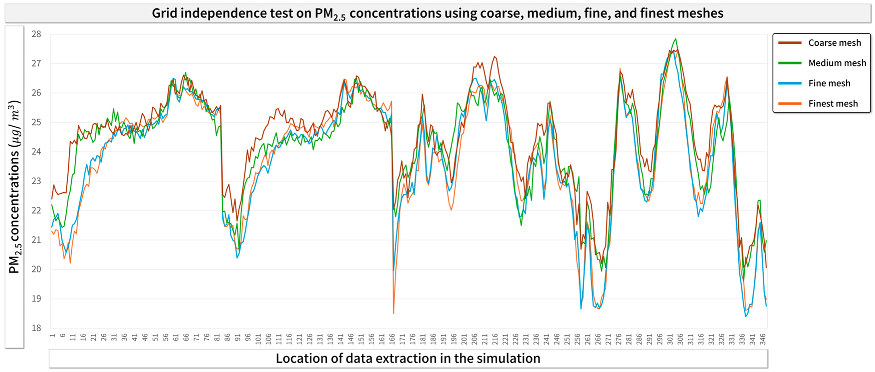
Appendix B. K-Fold Cross Validation Results (R2 and RMSE) for All Machine Learning Approach

References
- Xing, Y.-F.; Xu, Y.-H.; Shi, M.-H.; Lian, Y.-X. The Impact of PM2.5 on the Human Respiratory System. J. Thorac. Dis. 2016, 8, E69–E74. [Google Scholar] [CrossRef] [PubMed]
- Hayes, R.B.; Lim, C.; Zhang, Y.; Cromar, K.; Shao, Y.; Reynolds, H.R.; Silverman, D.T.; Jones, R.R.; Park, Y.; Jerrett, M.; et al. PM2.5 Air Pollution and Cause-Specific Cardiovascular Disease Mortality. Int. J. Epidemiol. 2020, 49, 25–35. [Google Scholar] [CrossRef] [PubMed]
- Maji, K.J.; Dikshit, A.K.; Arora, M.; Deshpande, A. Estimating Premature Mortality Attributable to PM2.5 Exposure and Benefit of Air Pollution Control Policies in China for 2020. Sci. Total Environ. 2018, 612, 683–693. [Google Scholar] [CrossRef]
- Requia, W.J.; Dalumpines, R.; Adams, M.D.; Arain, A.; Ferguson, M.; Koutrakis, P. Modeling Spatial Patterns of Link-Based PM2.5 Emissions and Subsequent Human Exposure in a Large Canadian Metropolitan Area. Atmos. Environ. 2017, 158, 172–180. [Google Scholar] [CrossRef]
- Shi, K.; Wang, H.; Yang, Q.; Wang, L.; Sun, X.; Li, Y. Exploring the Relationships between Urban Forms and Fine Particulate (PM2.5) Concentration in China: A Multi-Perspective Study. J. Clean. Prod. 2019, 231, 990–1004. [Google Scholar] [CrossRef]
- Clark, L.P.; Millet, D.B.; Marshall, J.D. Air Quality and Urban Form in U.S. Urban Areas: Evidence from Regulatory Monitors. Environ. Sci. Technol. 2011, 45, 7028–7035. [Google Scholar] [CrossRef]
- Li, X.; Feng, Y.J.; Liang, H.Y. The Impact of Meteorological Factors on PM2.5 Variations in Hong Kong. IOP Conf. Ser. Earth Environ. Sci. 2017, 78, 012003. [Google Scholar] [CrossRef]
- Guo, X.; Zhang, M.; Gao, Z.; Zhang, J.; Buccolieri, R. Neighborhood-Scale Dispersion of Traffic-Related PM2.5: Simulations of Nine Typical Residential Cases from Nanjing. Sustain. Cities Soc. 2023, 90, 104393. [Google Scholar] [CrossRef]
- Wang, F.; Peng, Y.; Jiang, C. Influence of Road Patterns on PM2.5 Concentrations and the Available Solutions: The Case of Beijing City, China. Sustainability 2017, 9, 217. [Google Scholar] [CrossRef]
- Chen, M.; Dai, F.; Yang, B.; Zhu, S. Effects of Neighborhood Green Space on PM2.5 Mitigation: Evidence from Five Megacities in China. Build. Environ. 2019, 156, 33–45. [Google Scholar] [CrossRef]
- Li, Z.; Fung, J.C.H.; Lau, A.K.H. High Spatiotemporal Characterization of On-Road PM2.5 Concentrations in High-Density Urban Areas Using Mobile Monitoring. Build. Environ. 2018, 143, 196–205. [Google Scholar] [CrossRef]
- Ke, B.; Hu, W.; Huang, D.; Zhang, J.; Lin, X.; Li, C.; Jin, X.; Chen, J. Three-Dimensional Building Morphology Impacts on PM2.5 Distribution in Urban Landscape Settings in Zhejiang, China. Sci. Total Environ. 2022, 826, 154094. [Google Scholar] [CrossRef] [PubMed]
- Hong, B.; Lin, B.; Qin, H. Numerical Investigation on the Effect of Avenue Trees on PM2.5 Dispersion in Urban Street Canyons. Atmosphere 2017, 8, 129. [Google Scholar] [CrossRef]
- Chatzimichailidis, A.E.; Argyropoulos, C.D.; Assael, M.J.; Kakosimos, K.E. Qualitative and Quantitative Investigation of Multiple Large Eddy Simulation Aspects for Pollutant Dispersion in Street Canyons Using OpenFOAM. Atmosphere 2019, 10, 17. [Google Scholar] [CrossRef]
- Li, F.; Rubinato, M.; Zhou, T.; Li, J.; Chen, C. Numerical Simulation of the Influence of Building-Tree Arrangements on Wind Velocity and PM2.5 Dispersion in Urban Communities. Sci. Rep. 2022, 12, 16378. [Google Scholar] [CrossRef]
- Hassan, A.M.; ELMokadem, A.A.; Megahed, N.A.; Abo Eleinen, O.M. Urban Morphology as a Passive Strategy in Promoting Outdoor Air Quality. J. Build. Eng. 2020, 29, 101204. [Google Scholar] [CrossRef]
- Liu, Y.; Miao, C.; Cui, A.; Wang, D. Spatial Distribution of Air Pollutants in Different Urban Functional Zones Based on Mobile Monitoring and CFD Simulation. Int. J. Environ. Sci. Technol. 2024, 1–14. [Google Scholar] [CrossRef]
- Chung, C.-Y.; Chung, P.-L. A Numerical and Experimental Study of Pollutant Dispersion in a Traffic Tunnel. Environ. Monit. Assess. 2007, 130, 289–299. [Google Scholar] [CrossRef]
- Miao, Y.; Liu, S.; Chen, B.; Zhang, B.; Wang, S.; Li, S. Simulating Urban Flow and Dispersion in Beijing by Coupling a CFD Model with the WRF Model. Adv. Atmos. Sci. 2013, 30, 1663–1678. [Google Scholar] [CrossRef]
- Chang, S.; Jiang, Q.; Zhao, Y. Integrating CFD and GIS into the Development of Urban Ventilation Corridors: A Case Study in Changchun City, China. Sustainability 2018, 10, 1814. [Google Scholar] [CrossRef]
- Fernández-Pacheco, V.M.; Álvarez-Álvarez, E.; Blanco-Marigorta, E.; Ackermann, T. CFD Model to Study PM 10 Dispersion in Large-Scale Open Spaces. Sci. Rep. 2023, 13, 5966. [Google Scholar] [CrossRef] [PubMed]
- Zhou, S.; Lin, R. Spatial-Temporal Heterogeneity of Air Pollution: The Relationship between Built Environment and on-Road PM2.5 at Micro Scale. Transp. Res. Part D Transp. Environ. 2019, 76, 305–322. [Google Scholar] [CrossRef]
- Gulia, S.; Shiva Nagendra, S.M.; Khare, M.; Khanna, I. Urban Air Quality Management-A Review. Atmos. Pollut. Res. 2015, 6, 286–304. [Google Scholar] [CrossRef]
- Bao, H.; Shan, L.; Wang, Y.; Jiang, Y.; Lee, C.; Cui, X. How Does Local Real Estate Investment Influence Neighborhood PM2.5 Concentrations? A Spatial Econometric Analysis. Land 2021, 10, 518. [Google Scholar] [CrossRef]
- Hoek, G.; Beelen, R.; de Hoogh, K.; Vienneau, D.; Gulliver, J.; Fischer, P.; Briggs, D. A Review of Land-Use Regression Models to Assess Spatial Variation of Outdoor Air Pollution. Atmos. Environ. 2008, 42, 7561–7578. [Google Scholar] [CrossRef]
- Kim, H.; Hong, S. Relationship between Land-Use Type and Daily Concentration and Variability of PM10 in Metropolitan Cities: Evidence from South Korea. Land 2022, 11, 23. [Google Scholar] [CrossRef]
- Zhang, Z.; Shan, B.; Lin, Q.; Chen, Y.; Yu, X. Influence of the Spatial Distribution Pattern of Buildings on the Distribution of PM2.5 Concentration. Stoch Environ. Res Risk Assess 2022, 36, 985–997. [Google Scholar] [CrossRef]
- Chen, G.; Li, S.; Knibbs, L.D.; Hamm, N.A.S.; Cao, W.; Li, T.; Guo, J.; Ren, H.; Abramson, M.J.; Guo, Y. A Machine Learning Method to Estimate PM2.5 Concentrations across China with Remote Sensing, Meteorological and Land Use Information. Sci. Total Environ. 2018, 636, 52–60. [Google Scholar] [CrossRef]
- Cui, P.; Dai, C.; Zhang, J.; Li, T. Assessing the Effects of Urban Morphology Parameters on PM2.5 Distribution in Northeast China Based on Gradient Boosted Regression Trees Method. Sustainability 2022, 14, 2618. [Google Scholar] [CrossRef]
- Zamani Joharestani, M.; Cao, C.; Ni, X.; Bashir, B.; Talebiesfandarani, S. PM2.5 Prediction Based on Random Forest, XGBoost, and Deep Learning Using Multisource Remote Sensing Data. Atmosphere 2019, 10, 373. [Google Scholar] [CrossRef]
- Ren, L.; An, F.; Su, M.; Liu, J. Exposure Assessment of Traffic-Related Air Pollution Based on CFD and BP Neural Network and Artificial Intelligence Prediction of Optimal Route in an Urban Area. Buildings 2022, 12, 1227. [Google Scholar] [CrossRef]
- Jiang, Z.; Cheng, H.; Zhang, P.; Kang, T. Influence of Urban Morphological Parameters on the Distribution and Diffusion of Air Pollutants: A Case Study in China. J. Environ. Sci. 2021, 105, 163–172. [Google Scholar] [CrossRef] [PubMed]
- Kwak, K.-H.; Baik, J.-J.; Ryu, Y.-H.; Lee, S.-H. Urban Air Quality Simulation in a High-Rise Building Area Using a CFD Model Coupled with Mesoscale Meteorological and Chemistry-Transport Models. Atmos. Environ. 2015, 100, 167–177. [Google Scholar] [CrossRef]
- Huang, C.; Hu, T.; Duan, Y.; Li, Q.; Chen, N.; Wang, Q.; Zhou, M.; Rao, P. Effect of Urban Morphology on Air Pollution Distribution in High-Density Urban Blocks Based on Mobile Monitoring and Machine Learning. Build. Environ. 2022, 219, 109173. [Google Scholar] [CrossRef]
- Liu, X.; Shi, X.-Q.; Li, X.-B.; Peng, Z.-R. Quantification of Multifactorial Effects on Particle Distributions at Urban Neighborhood Scale Using Machine Learning and Unmanned Aerial Vehicle Measurement. J. Clean. Prod. 2022, 378, 134494. [Google Scholar] [CrossRef]
- Lange, M.; Suominen, H.; Kurppa, M.; Järvi, L.; Oikarinen, E.; Savvides, R.; Puolamäki, K. Machine-Learning Models to Replicate Large-Eddy Simulations of Air Pollutant Concentrations along Boulevard-Type Streets. Geosci. Model Dev. 2021, 14, 7411–7424. [Google Scholar] [CrossRef]
- Panchigar, D.; Kar, K.; Shukla, S.; Mathew, R.M.; Chadha, U.; Selvaraj, S.K. Machine Learning-Based CFD Simulations: A Review, Models, Open Threats, and Future Tactics. Neural Comput. Appl. 2022, 34, 21677–21700. [Google Scholar] [CrossRef]
- Wang, R.; Kim, J.-H.; Li, M.-H. Predicting Stream Water Quality under Different Urban Development Pattern Scenarios with an Interpretable Machine Learning Approach. Sci. Total Environ. 2021, 761, 144057. [Google Scholar] [CrossRef]
- Pantusheva, M.; Mitkov, R.; Hristov, P.O.; Petrova-Antonova, D. Air Pollution Dispersion Modelling in Urban Environment Using CFD: A Systematic Review. Atmosphere 2022, 13, 1640. [Google Scholar] [CrossRef]
- Wu, Q.; Wang, Y.; Sun, H.; Lin, H.; Zhao, Z. A System Coupled GIS and CFD for Atmospheric Pollution Dispersion Simulation in Urban Blocks. Atmosphere 2023, 14, 832. [Google Scholar] [CrossRef]
- Makvandi, M.; Yuan, P.F.; Ji, Q.; Li, C.; Elsadek, M.; Li, W.; Hassan, A.; Li, Y. Resilience to Climate Change by Improving Air Circulation Efficiency and Pollutant Dispersion in Cities: A 3D-UFO Approach to Urban Block Design. Heliyon 2024, 10, e36904. [Google Scholar] [CrossRef] [PubMed]
- Menter, F. Zonal Two Equation K-w Turbulence Models For Aerodynamic Flows. In Proceedings of the 23rd Fluid Dynamics, Plasmadynamics, and Lasers Conference, Orlando, FL, USA, 6 July 1993; American Institute of Aeronautics and Astronautics: Reston, VA, USA, 1993. [Google Scholar]
- Menter, F.R. Two-Equation Eddy-Viscosity Turbulence Models for Engineering Applications. AIAA J. 1994, 32, 1598–1605. [Google Scholar] [CrossRef]
- Yuan, C.; Ng, E.; Norford, L.K. Improving Air Quality in High-Density Cities by Understanding the Relationship between Air Pollutant Dispersion and Urban Morphologies. Build. Environ. 2014, 71, 245–258. [Google Scholar] [CrossRef] [PubMed]
- Kummitha, O.R.; Kumar, R.V.; Krishna, V.M. CFD Analysis for Airflow Distribution of a Conventional Building Plan for Different Wind Directions. J. Comput. Des. Eng. 2021, 8, 559–569. [Google Scholar] [CrossRef]
- ANSYS Inc. ANSYS FLUENT Theory Guide; ANSYS Inc.: Canonsburg, PA, USA, 2023. [Google Scholar]
- Zhang, Z.; Chen, Q. Experimental Measurements and Numerical Simulations of Particle Transport and Distribution in Ventilated Rooms. Atmos. Environ. 2006, 40, 3396–3408. [Google Scholar] [CrossRef]
- Spalding, D.B. Mixing and Chemical Reaction in Steady Confined Turbulent Flames. Symp. Int. Combust. 1971, 13, 649–657. [Google Scholar] [CrossRef]
- Wang, X.; McNamara, K.F. Evaluation of CFD Simulation Using RANS Turbulence Models for Building Effects on Pollutant Dispersion. Environ. Fluid Mech. 2006, 6, 181–202. [Google Scholar] [CrossRef]
- Tominaga, Y.; Mochida, A.; Yoshie, R.; Kataoka, H.; Nozu, T.; Yoshikawa, M.; Shirasawa, T. AIJ Guidelines for Practical Applications of CFD to Pedestrian Wind Environment around Buildings. J. Wind Eng. Ind. Aerodyn. 2008, 96, 1749–1761. [Google Scholar] [CrossRef]
- Jia, Y.-P.; Lu, K.-F.; Zheng, T.; Li, X.-B.; Liu, X.; Peng, Z.-R.; He, H.-D. Effects of Roadside Green Infrastructure on Particle Exposure: A Focus on Cyclists and Pedestrians on Pathways between Urban Roads and Vegetative Barriers. Atmos. Pollut. Res. 2021, 12, 1–12. [Google Scholar] [CrossRef]
- Hang, J.; Li, Y.; Sandberg, M.; Buccolieri, R.; Di Sabatino, S. The Influence of Building Height Variability on Pollutant Dispersion and Pedestrian Ventilation in Idealized High-Rise Urban Areas. Build. Environ. 2012, 56, 346–360. [Google Scholar] [CrossRef]
- Han, J.; Lee, J. A Comparative Study of Air Pollution Levels in Different Urban Street Configurations in Pangyo New Town, South Korea. Build. Environ. 2023, 243, 110695. [Google Scholar] [CrossRef]
- Antoniou, N.; Montazeri, H.; Neophytou, M.; Blocken, B. CFD Simulation of Urban Microclimate: Validation Using High4Resolution Field Measurements. Sci. Total Environ. 2019, 695, 133743. [Google Scholar] [CrossRef] [PubMed]
- Elraouf, R.A.; ELMokadem, A.; Megahed, N.; Eleinen, O.A.; Eltarabily, S. Evaluating Urban Outdoor Thermal Comfort: A Validation of ENVI-Met Simulation through Field Measurement. J. Build. Perform. Simul. 2022, 15, 268–286. [Google Scholar] [CrossRef]
- Toparlar, Y.; Blocken, B.; Vos, P.; van Heijst, G.J.F.; Janssen, W.D.; van Hooff, T.; Montazeri, H.; Timmermans, H.J.P. CFD Simulation and Validation of Urban Microclimate: A Case Study for Bergpolder Zuid, Rotterdam. Build. Environ. 2015, 83, 79–90. [Google Scholar] [CrossRef]
- Md Saad, Z.; Rasdi, I.; Zainal Abidin, E. Indoor Air Quality and Prevalence of Sick Building Syndrome among University Laboratory Workers. Sci. Basic Appl. Res. 2016, 29, 130–140. [Google Scholar]
- Rodes, C.E.; Thornburg, J.W. Breathing Zone Exposure Assessment. In Aerosols Handbook; CRC Press: Boca Raton, FL, USA, 2004; pp. 77–90. [Google Scholar]
- Thornburg, J.; Kominsky, J.; Brown, G.G.; Frechtel, P.; Barrett, W.; Shaul, G. A Model to Predict the Breathing Zone Concentrations of Particles Emitted from Surfaces. J. Environ. Monit. 2010, 12, 973–980. [Google Scholar] [CrossRef]
- Feng, H.; Feng, H. Correlation Analysis Between PM2.5 Concentration and Meteorological, Vegetation and Topographical Factors in the Urbanized Ecosystem in Beijing, China. NEPT 2020, 19, 1399–1410. [Google Scholar] [CrossRef]
- Kubota, T.; Miura, M.; Tominaga, Y.; Mochida, A. Wind Tunnel Tests on the Relationship between Building Density and Pedestrian-Level Wind Velocity: Development of Guidelines for Realizing Acceptable Wind Environment in Residential Neighborhoods. Build. Environ. 2008, 43, 1699–1708. [Google Scholar] [CrossRef]
- Hanna, B.N.; Dinh, N.T.; Youngblood, R.W.; Bolotnov, I.A. Machine-Learning Based Error Prediction Approach for Coarse-Grid Computational Fluid Dynamics (CG-CFD). Prog. Nucl. Energy 2020, 118, 103140. [Google Scholar] [CrossRef]
- Hashad, K.; Gu, J.; Yang, B.; Rong, M.; Chen, E.; Ma, X.; Zhang, K.M. Designing Roadside Green Infrastructure to Mitigate Traffic-Related Air Pollution Using Machine Learning. Sci. Total Environ. 2021, 773, 144760. [Google Scholar] [CrossRef]
- Liu, X.; Shi, X.-Q.; Peng, Z.-R.; He, H.-D. Quantifying the Effects of Urban Fabric and Vegetation Combination Pattern to Mitigate Particle Pollution in Near-Road Areas Using Machine Learning. Sustain. Cities Soc. 2023, 93, 104524. [Google Scholar] [CrossRef]
- Wu, C.; He, H.; Song, R.; Peng, Z. Prediction of Air Pollutants on Roadside of the Elevated Roads with Combination of Pollutants Periodicity and Deep Learning Method. Build. Environ. 2022, 207, 108436. [Google Scholar] [CrossRef]
- Snoek, J.; Larochelle, H.; Adams, R.P. Practical Bayesian Optimization of Machine Learning Algorithms. Adv. Neural Inf. Process. Syst. 2012, 25, 2951–2959. [Google Scholar]
- Shapley, L.S. Stochastic Games*. Proc. Natl. Acad. Sci. USA 1953, 39, 1095–1100. [Google Scholar] [CrossRef]
- Lundberg, S.M.; Lee, S.-I. Consistent Feature Attribution for Tree Ensembles. arXiv 2017, arXiv:1706.06060. [Google Scholar]
- Chan, T.L.; Dong, G.; Leung, C.W.; Cheung, C.S.; Hung, W.T. Validation of a Two-Dimensional Pollutant Dispersion Model in an Isolated Street Canyon. Atmos. Environ. 2002, 36, 861–872. [Google Scholar] [CrossRef]
- Huang, Y.-D.; Xu, X.; Liu, Z.-Y.; Deng, J.-T.; Kim, C.-N. Impacts of Shape and Height of Building Roof on Airflow and Pollutant Dispersion inside an Isolated Street Canyon. Environ. Forensics 2016, 17, 361–379. [Google Scholar] [CrossRef]
- Huang, Y.-D.; Hou, R.-W.; Liu, Z.-Y.; Song, Y.; Cui, P.-Y.; Kim, C.-N. Effects of Wind Direction on the Airflow and Pollutant Dispersion inside a Long Street Canyon. Aerosol Air Qual. Res. 2019, 19, 1152–1171. [Google Scholar] [CrossRef]
- Murena, F.; Mele, B. Effect of Short–Time Variations of Wind Velocity on Mass Transfer Rate between Street Canyons and the Atmospheric Boundary Layer. Atmos. Pollut. Res. 2014, 5, 484–490. [Google Scholar] [CrossRef]
- Klein, P.M.; Galvez, J.M. Flow and Turbulence Characteristics in a Suburban Street Canyon. Environ. Fluid Mech. 2015, 15, 419–438. [Google Scholar] [CrossRef]
- Li, X.-X.; Liu, C.-H.; Leung, D.Y.C. Large-Eddy Simulation of Flow and Pollutant Dispersion in High-Aspect-Ratio Urban Street Canyons with Wall Model. Bound.-Layer Meteorol. 2008, 129, 249–268. [Google Scholar] [CrossRef]
- Liu, C.-H.; Barth, M.C.; Leung, D.Y. Large-Eddy Simulation of Flow and Pollutant Transport in Street Canyons of Different Building-Height-to-Street-Width Ratios. J. Appl. Meteorol. 2004, 43, 1410–1424. [Google Scholar] [CrossRef]
- Li, X.-X.; Liu, C.-H.; Leung, D.Y. Numerical Investigation of Pollutant Transport Characteristics inside Deep Urban Street Canyons. Atmos. Environ. 2009, 43, 2410–2418. [Google Scholar] [CrossRef]
- Yin, Q.; Wang, J.; Hu, M.; Wong, H. Estimation of Daily PM2.5 Concentration and Its Relationship with Meteorological Conditions in Beijing. J. Environ. Sci. 2016, 48, 161–168. [Google Scholar] [CrossRef]
- Zhang, B.; Jiao, L.; Xu, G.; Zhao, S.; Tang, X.; Zhou, Y.; Gong, C. Influences of Wind and Precipitation on Different-Sized Particulate Matter Concentrations (PM2.5, PM10, PM2.5–10). Meteorol. Atmos. Phys. 2018, 130, 383–392. [Google Scholar] [CrossRef]
- Chew, L.W.; Norford, L.K. Pedestrian-Level Wind Speed Enhancement in Urban Street Canyons with Void Decks. Build. Environ. 2018, 146, 64–76. [Google Scholar] [CrossRef]
- Baik, J.-J.; Kwak, K.-H.; Park, S.-B.; Ryu, Y.-H. Effects of Building Roof Greening on Air Quality in Street Canyons. Atmos. Environ. 2012, 61, 48–55. [Google Scholar] [CrossRef]
- Yeom, S.H.; Na, J.S.; Jung, H.-D.; Cho, H.-J.; Choi, Y.J.; Lee, J.S. Computational Analysis of Airflow Dynamics for Predicting Collapsible Sites in the Upper Airways: Machine Learning Approach. J. Appl. Physiol. 2019, 127, 959–973. [Google Scholar] [CrossRef]
- Yang, J.; Shi, B.; Shi, Y.; Marvin, S.; Zheng, Y.; Xia, G. Air Pollution Dispersal in High Density Urban Areas: Research on the Triadic Relation of Wind, Air Pollution, and Urban Form. Sustain. Cities Soc. 2020, 54, 101941. [Google Scholar] [CrossRef]
- Hong, B.; Lin, B.; Qin, H. Numerical Investigation on the Coupled Effects of Building-Tree Arrangements on Fine Particulate Matter (PM2.5) Dispersion in Housing Blocks. Sustain. Cities Soc. 2017, 34, 358–370. [Google Scholar] [CrossRef]
- Pan, J.; Ji, J. Influence of Building Height Variation on Air Pollution Dispersion in Different Wind Directions: A Numerical Simulation Study. Appl. Sci. 2024, 14, 979. [Google Scholar] [CrossRef]
- Gromke, C.; Ruck, B. Pollutant Concentrations in Street Canyons of Different Aspect Ratio with Avenues of Trees for Various Wind Directions. Bound.-Layer Meteorol 2012, 144, 41–64. [Google Scholar] [CrossRef]
- Song, X.; Zhang, Y.; Zhang, G.; Zhao, Y. Factors Evaluation of PM2.5 Diffusion in Street Canyons in Dalian Based on Numerical Simulation. Build. Simul. 2025, 18, 619–639. [Google Scholar] [CrossRef]
- Wang, B.; Li, Y.; Tang, Z.; Cai, N.; Niu, H. Effects of Vehicle Emissions on the PM2.5 Dispersion and Intake Fraction in Urban Street Canyons. J. Clean. Prod. 2021, 324, 129212. [Google Scholar] [CrossRef]
- Wang, W.; Chen, H.; Lai, Y. Modeling Airflow Dynamics and Their Effects on PM2.5 Concentrations in Urban Ventilation Corridors of Hangzhou. Sci. Total Environ. 2024, 957, 177794. [Google Scholar] [CrossRef]
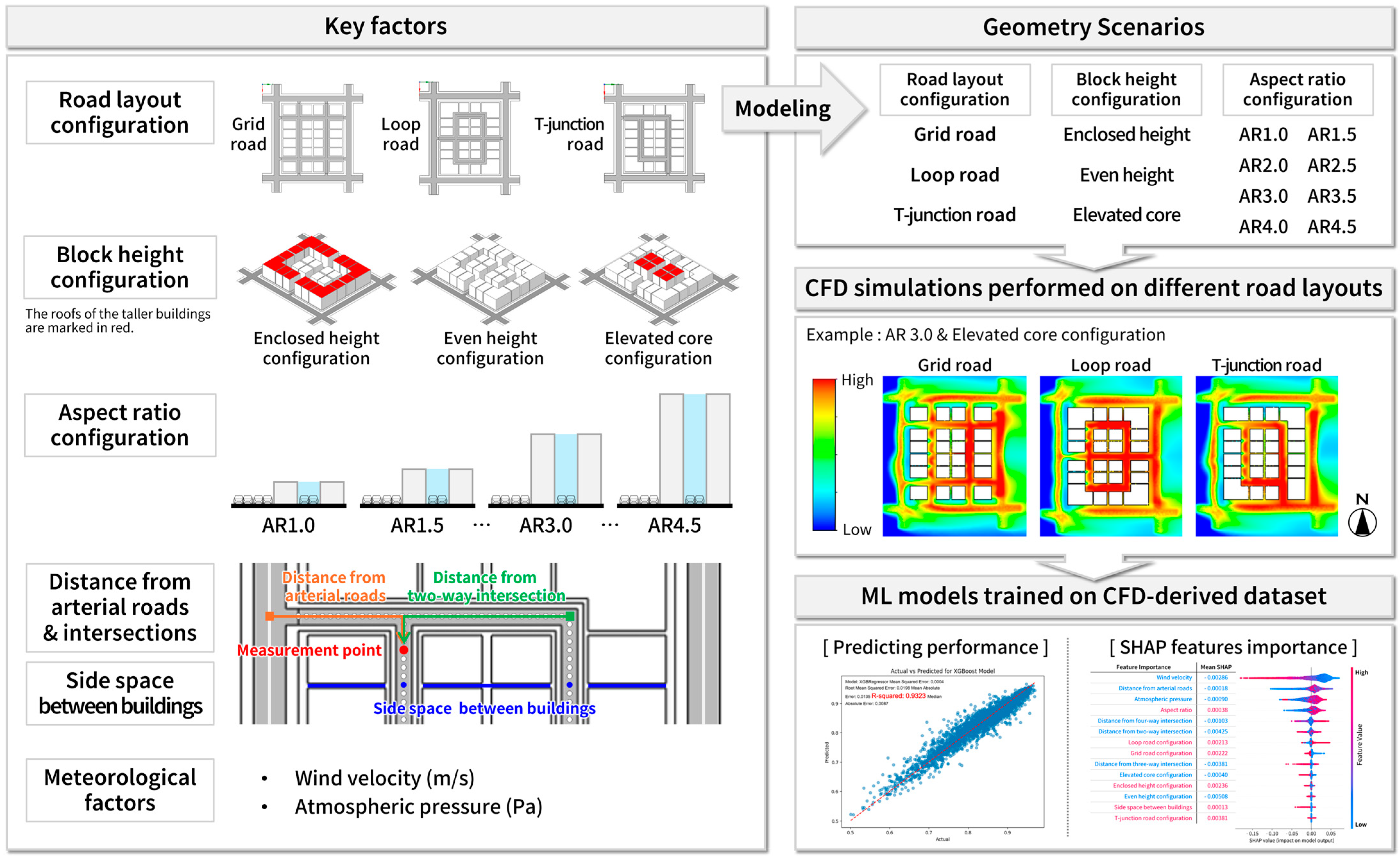

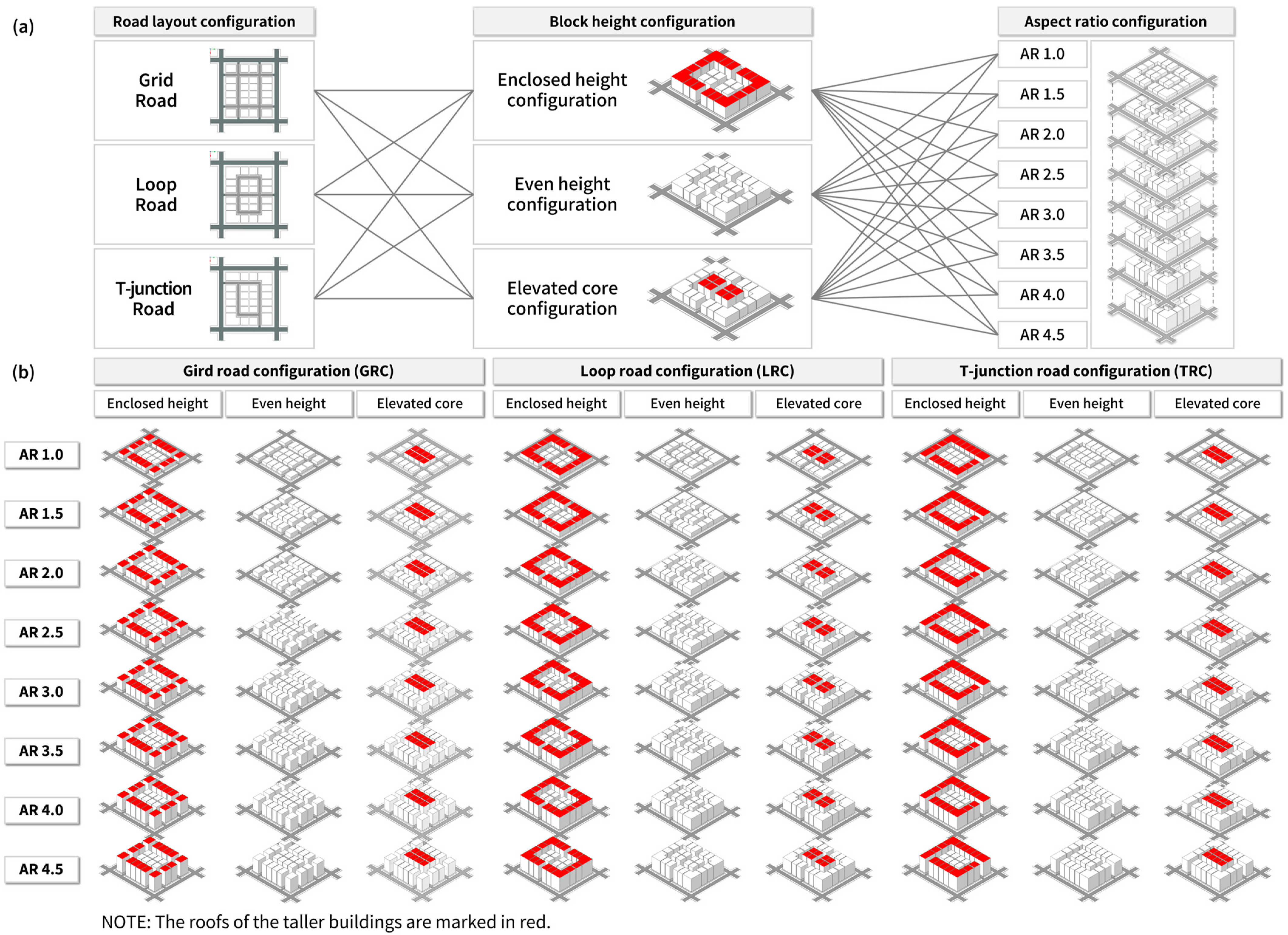
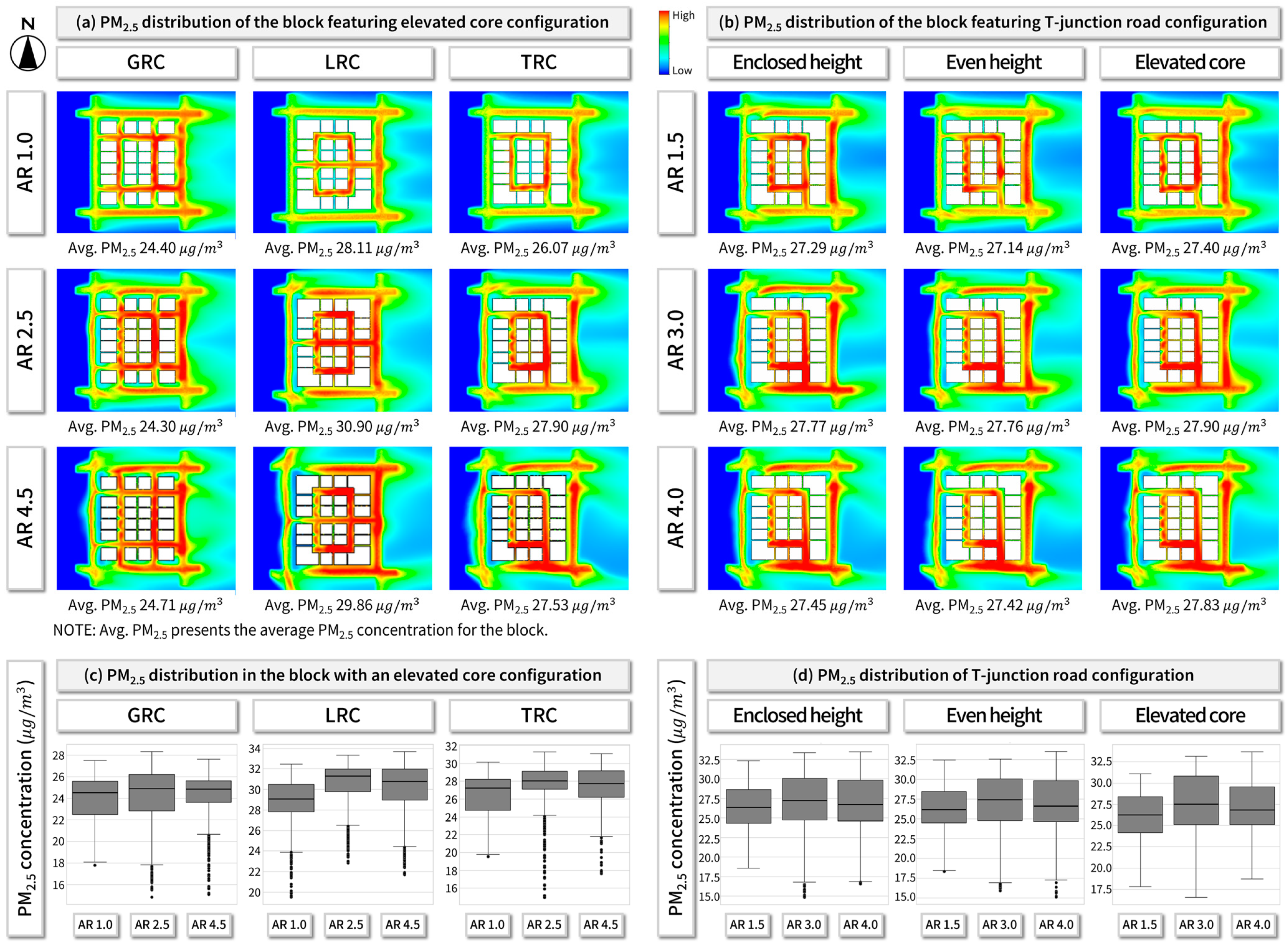

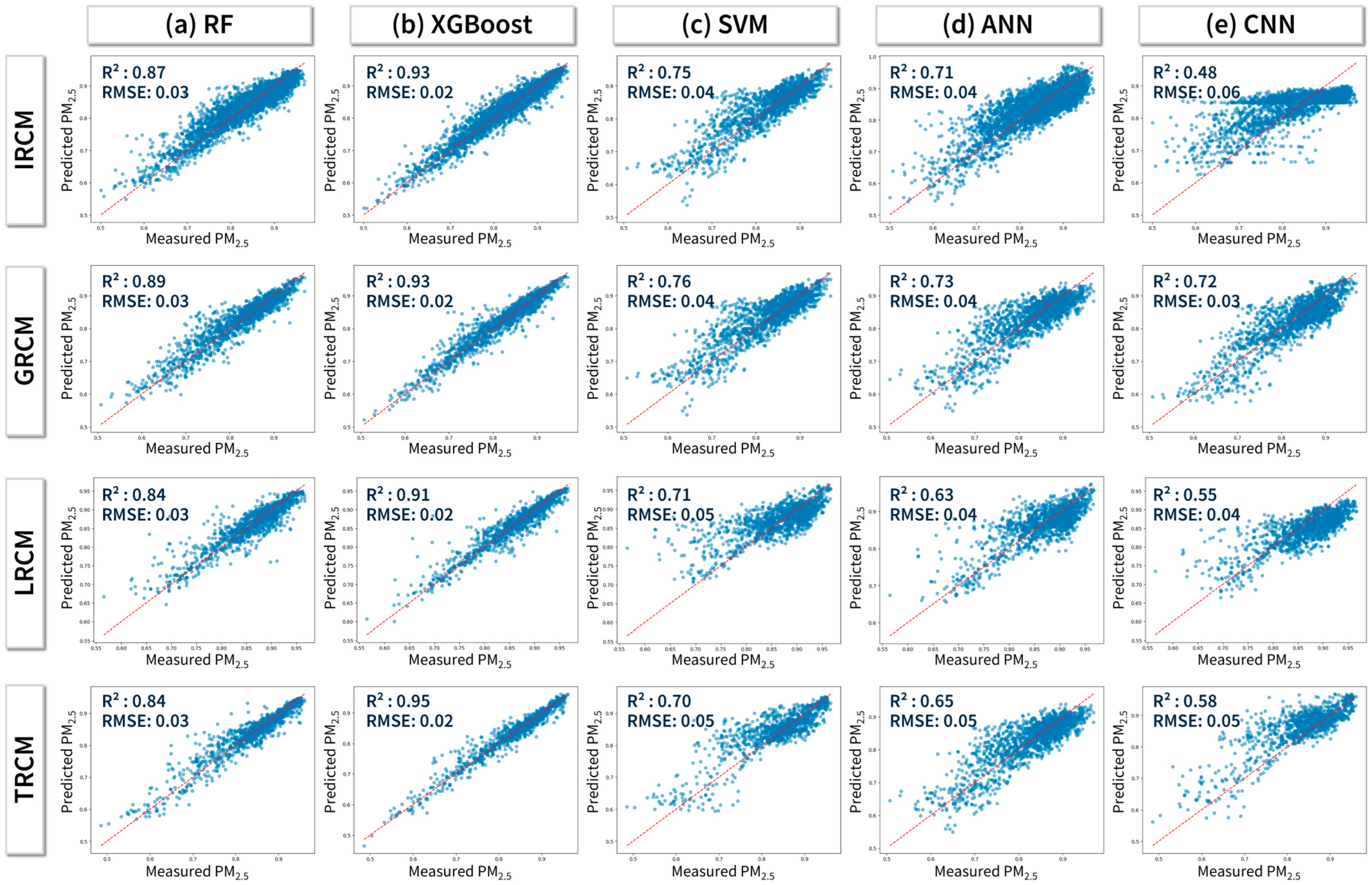

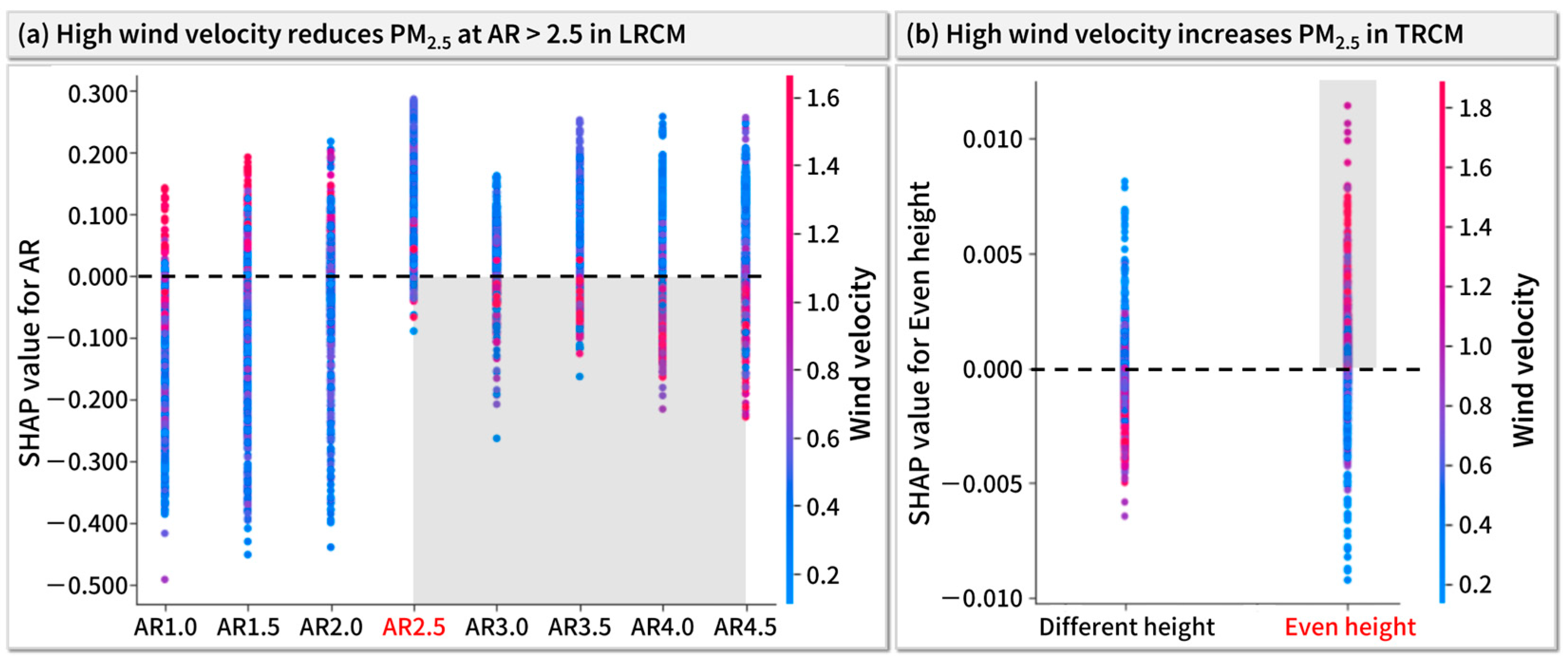
| Variables | Variables’ Value Range | |
|---|---|---|
| Urban morphology factors | Road layout configuration | GRC, LRC, and TRC |
| Aspect ratio configuration | 1, 1.5, 2, 2.5, 3, 3.5, 4, and 4.5 | |
| Block height configuration | Enclosed height configuration Even height configuration Elevated core configuration | |
| Side space between buildings | Existence (1) and absence (0) | |
| Traffic-related factors | Distance from arterial roads | Network distance from a central line of arterial roads or the center of each intersection |
| Distance from two-way intersection | ||
| Distance from three-way intersection | ||
| Distance from four-way intersection | ||
| Meteorological factors | Wind velocity | Data Extracted from CFD simulation results |
| Atmospheric pressure | ||
| ML Models | Parameters | IRCM * | GRCM * | LRCM * | TRCM * |
|---|---|---|---|---|---|
| RF | Max depth | 12 | 10 | 12 | 12 |
| Max features | 11 | 9 | 8 | 11 | |
| Min sample split | 10 | 10 | 10 | 10 | |
| Min sample leaf | 10 | 10 | 10 | 10 | |
| N estimators | 2000 | 1658 | 2000 | 1855 | |
| XGBoost | Max depth | 12 | 12 | 15 | 12 |
| N estimators | 234 | 899 | 988 | 997 | |
| Learning rate | 0.090 | 0.019 | 0.389 | 0.172 | |
| Subsample ratio | 0.923 | 0.203 | 0.865 | 0.462 | |
| Subsampling ratio by tree | 0.997 | 0.934 | 0.975 | 0.842 | |
| SVM | Regularization parameter | 4.361 | 3.396 | 1.795 | 1.796 |
| Epsilon | 0.002 | 0.001 | 0.001 | 0.000 | |
| Kernel | rbf | rbf | rbf | rbf | |
| ANN | Hidden layer sizes | 500 | 199 | 378 | 477 |
| Alpha | 0.0001 | 0.0001 | 0.0001 | 0.0247 | |
| Activation | tanh | tanh | tanh | logistic | |
| Learning rate | 0.001 | 0.001 | 0.001 | 0.001 | |
| CNN | Filters | 16 | 16 | 128 | 128 |
| Kernel size | 3 | 2 | 3 | 2 | |
| Dropout rate | 0.370 | 0.100 | 0.103 | 0.322 | |
| Learning rate | 0.009 | 0.010 | 0.003 | 0.008 |
| ML Models | IRCM | GRCM | LRCM | TRCM | ||||
|---|---|---|---|---|---|---|---|---|
| R2 | RMSE | R2 | RMSE | R2 | RMSE | R2 | RMSE | |
| RF | 0.87 | 0.03 | 0.89 | 0.03 | 0.84 | 0.03 | 0.84 | 0.03 |
| XGBoost | 0.93 | 0.02 | 0.93 | 0.02 | 0.91 | 0.02 | 0.95 | 0.02 |
| SVM | 0.75 | 0.04 | 0.76 | 0.04 | 0.71 | 0.05 | 0.70 | 0.05 |
| ANN | 0.71 | 0.04 | 0.73 | 0.04 | 0.63 | 0.04 | 0.65 | 0.05 |
| CNN | 0.48 | 0.06 | 0.72 | 0.03 | 0.55 | 0.04 | 0.58 | 0.05 |
Disclaimer/Publisher’s Note: The statements, opinions and data contained in all publications are solely those of the individual author(s) and contributor(s) and not of MDPI and/or the editor(s). MDPI and/or the editor(s) disclaim responsibility for any injury to people or property resulting from any ideas, methods, instructions or products referred to in the content. |
© 2025 by the authors. Licensee MDPI, Basel, Switzerland. This article is an open access article distributed under the terms and conditions of the Creative Commons Attribution (CC BY) license (https://creativecommons.org/licenses/by/4.0/).
Share and Cite
Lee, D.; Barquilla, C.A.M.; Lee, J. Analyzing Dispersion Characteristics of Fine Particulate Matter in High-Density Urban Areas: A Study Using CFD Simulation and Machine Learning. Land 2025, 14, 632. https://doi.org/10.3390/land14030632
Lee D, Barquilla CAM, Lee J. Analyzing Dispersion Characteristics of Fine Particulate Matter in High-Density Urban Areas: A Study Using CFD Simulation and Machine Learning. Land. 2025; 14(3):632. https://doi.org/10.3390/land14030632
Chicago/Turabian StyleLee, Daeun, Caryl Anne M. Barquilla, and Jeongwoo Lee. 2025. "Analyzing Dispersion Characteristics of Fine Particulate Matter in High-Density Urban Areas: A Study Using CFD Simulation and Machine Learning" Land 14, no. 3: 632. https://doi.org/10.3390/land14030632
APA StyleLee, D., Barquilla, C. A. M., & Lee, J. (2025). Analyzing Dispersion Characteristics of Fine Particulate Matter in High-Density Urban Areas: A Study Using CFD Simulation and Machine Learning. Land, 14(3), 632. https://doi.org/10.3390/land14030632






